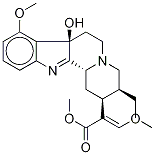Description
7-Hydroxymitragynine is a terpenoid indole alkaloid from the plant Mitragyna speciosa, It is a minor constituent of this plant (Ponglux et al., 1994). 7-Hydroxymitragynine exhibited a higher potency than mitragynine in the guinea-pig ileum test and a high affinity for A-opioid receptors in binding assays (Takayama et al., 2002).
Uses
A metabolite of Mitragynine. Along with mitragynine, 7-Hydroxymitragynine is an active alkaloid found in the plant Mitragynine speciosa, commonly known as Kratom. The compound possesses opioid agonistic activity with a potentcy 30- and 17-fold higher than that of mitragynine and morphine, respectively.
Definition
ChEBI: 7-Hydroxymitragynine is an alkaloid.
Preparation
7-Hydroxymitragynine is produced by oxidation of mitragynine and is a minor constituent (< 0.01% in fresh leaves) found at concentrations of up to 2% in leaf extracts and commercial kratom products; however, it is believed to be the major contributor to the known addictive potential of kratom given its activity as a potent μ-opioid receptor agonist.
Pharmacokinetics
Mitragynine and 7-hydroxymitragynine are partial agonists at the mu-opioid receptor. Human studies demonstrate the analgesic effects of kratom, while kratom extract, mitragynine and 7-hydroxymitragynine have been shown to be antinociceptive in animal models. The antinociceptive effects are reversed by an opioid antagonist.
Mitragynine also binds to adrenergic receptors, serotonergic and dopamine receptors. Although there is limited information regarding its effects at these receptors, kratom extracts and mitragynine have been reported in animal studies to have a variety of non-opioid-like behavioural effects, including antidepressant and antipsychotic effects.



